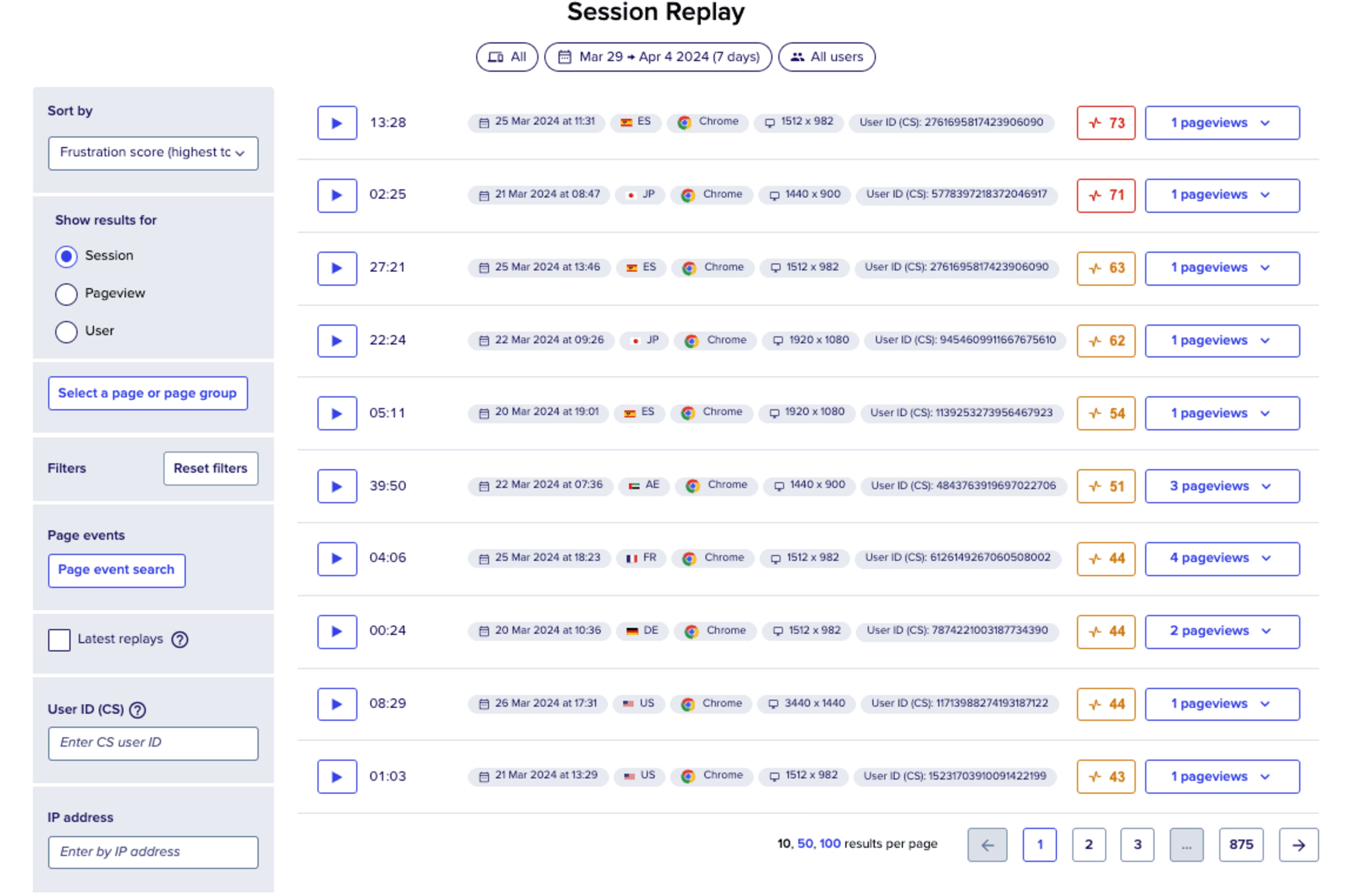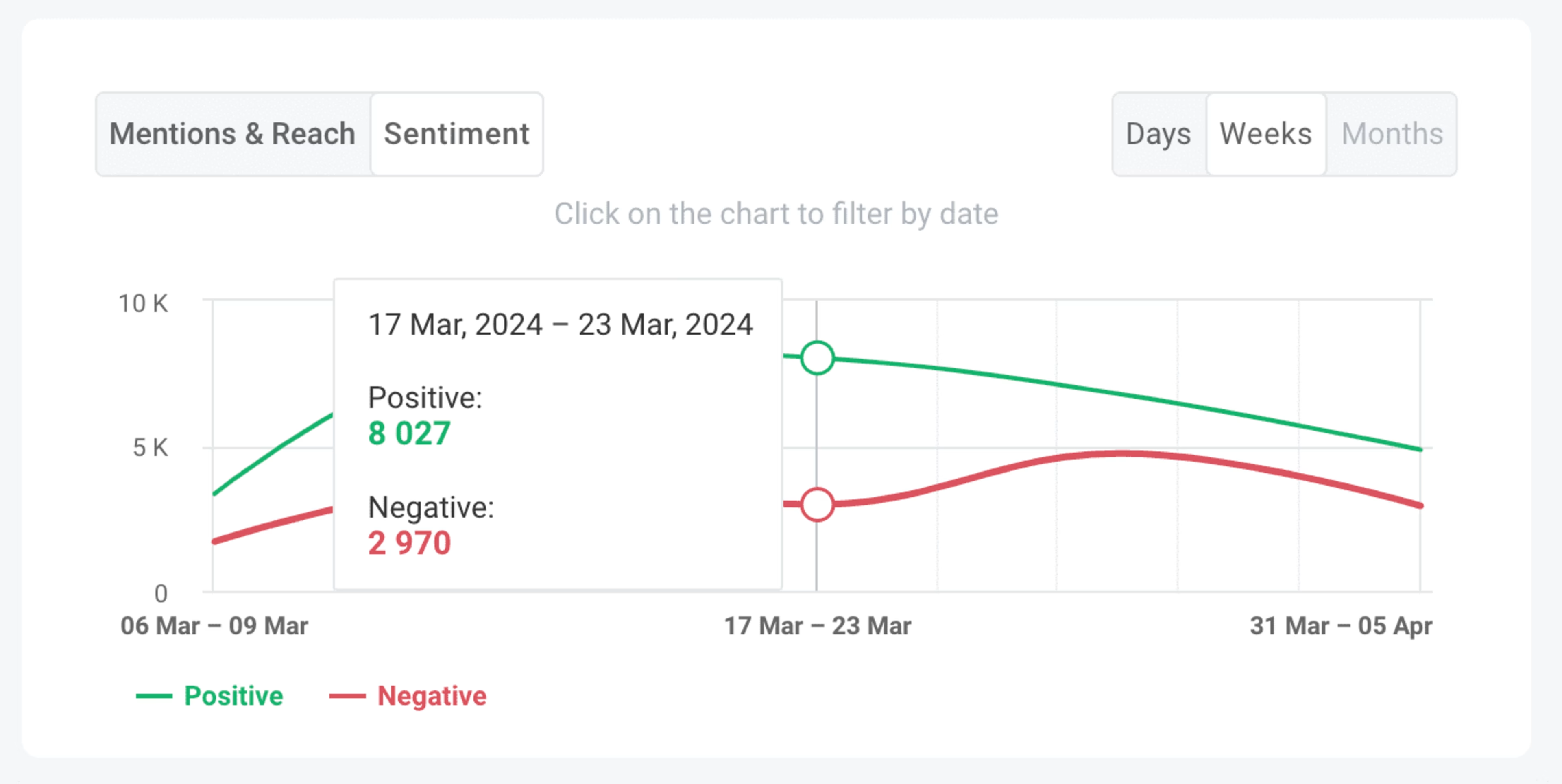We’ll admit: those of us who actively use data insights often feel overwhelmed by huge datasets and spreadsheets—and bogged down by the steps involved in analyzing them.
Luckily, artificial intelligence (AI) is here to take over the data analysis and processing tasks we don’t have time for or simply don’t want to do—and we’re not just talking about ChatGPT.
The best AI tools use machine learning (ML) algorithms and natural language processing (NLP) to make sense of your data sources—giving you actionable insights and suggesting solutions in a user-friendly interface, so you can make decisions faster, optimize your user experience and improve conversion rates.
1. Contentsquare: frustration scoring
Contentsquare is an all-in-one digital experience analytics platform that lets you automatically capture behavioral and performance data on your website and apps in a secure way. One of the best parts of Contentsquare is that it offers AI-powered insights to help you quickly improve your customer journey.
Using advanced machine learning algorithms, Contentsquare ranks your sessions and pages where users experienced the most friction, based on their impact on experience, conversion, and revenue, and assigns them a Frustration Score.

Continuously monitoring the digital experience and promptly reacting to changes in the Frustration Score lets you proactively address issues, optimize user engagement, and maintain a seamless online experience, ultimately leading to improved customer retention and loyalty. Request a demo to learn more.
💡Pro tip: use Contentsquare’s other products to fully understand your users’ digital experience. The platform includes
Customer Journey Analysis, which gives you color-coded visuals of how users progress through your site, so you can find opportunities for improvement
Product Analytics to understand multi-session user journeys across all of your websites, apps and other branded experiences, so you can improve retention and growth
Form Analysis to show you how users interact with on-site forms, so you can optimize the experience
Error Analysis, which helps you find and fix technical blockers and functional errors to create a seamless user experience
Speed Analysis to monitor web performance metrics and find the root cause of issues that impact conversion and bounce rates
2. Brand24: social listening
Brand24 has moved from a simple media monitoring tool that just provided raw data—to an AI-powered social listening tool that provides AI-based solutions for your brand.
Main Brand24 dashboard featuring mentions for Microsoft. Source: Brand24.com
The media monitoring tool gathers all publicly available online mentions of your brand (or any given keyword—depending on your project) and uses AI data analysis to measure sentiment, social and non-social reach, and advertising value equivalent (AVE).

Analyzing user sentiment for Microsoft. Source: Brand24.com
The AI tool is useful for marketers, PR professionals, and business owners—anyone wanting to track what people say about your brand online and analyze how it impacts the business.
Additionally, Brand24 offers experimental AI-powered features—like topic, geo, and emotion analysis. But perhaps Brand24’s most advanced AI-powered feature is its AI report that provides meaningful insights about the brand’s health and reach. Brand24 is a paid tool, but you can grab a free 14-day trial and see if it works for you.
3. Microsoft Power BI: data visualization
Microsoft Power BI is a versatile data analysis suite for businesses who want to dig deeper into various metrics and insights, and improve their data-driven decision-making.
Microsoft Power BI gives you interactive visualizations and business intelligence capabilities with a simple interface and drag-and-drop functionality, so you can create your own reports and dashboards. Key features of the tool include data integration, data transformation and modeling, data visualization and advanced analytics.
Many of these features offer AI-powered capabilities. For example, the smart narrative visualization feature automatically creates text-based summaries of your charts and graphs. When added to a PowerPoint, this product summary updates each time you refresh the page.
Power BI is designed for a wide range of users with different roles and needs in an organization.
You can try Power BI with a free Microsoft Fabric Preview account.
4. Sprinklr: social media management
If you’re a marketer with a social media marketing strategy, then you definitely need a management tool, so why not choose one that’s AI-powered?
Sprinklr is a conversational and generative AI platform that does everything that a regular social media management tool does, plus has a few AI features available for subscribers.**The first one is the AI assistant that writes your posts for you. The other, surely more interesting for this article’s readers, is the AI-based data analysis tool.**
Sprinklr also has a data analysis tool that includes social listening, product insights, and benchmarking. Basically, it gives you everything you need to gain valuable insights about the state of your social media platforms and how they benchmark against your competition.
You can get a 90-day trial for free.
5. SimilarWeb: advanced competitor analysis
The next on the list is SimilarWeb, a well-known analytics tool for competitor analysis.SimilarWeb usesadvanced techniques such as machine learning to predict basic metrics such as your number of visitors, bounce rate, pages per visit, or average visit duration on almost any given website. It also provides data about companies, such as the number of employees, location or annual revenue (if publicly available).
The platform’s AI assistant, called SimilarAsk™, answers users’ analytics questions. Combined with an AI model like OpenAI, the tool lets you quickly locate insights within SimilarWeb. For example, when you type a question into the navigation bar, SimilarAsk responds with a list of pages in the platform that provide you with relevant data.
6. Optimizely: A/B testing
All marketers should know the great power of A/B testing, and Optimizely is here to help.
Whether your product is already on the market, a new feature has just been introduced, or you’re still developing a Minimum Viable Product (MVP), conducting A/B testing (or multivariate testing) is certainly worth your while. This approach helps you determine which version of your product or feature is more favored by users and which leads to higher conversion rates.
Optimizely is a huge platform dedicated to just that—testing your web designs and content. You can run multiple tests and observe the results to choose the best version.
Optimizely also has an abundance of AI-powered features that help you iterate content better and faster. The platform’s smart AI assistant, Opal, generates and tags images and creates copy and content.
Which AI analytics tool should you use?
The tools above give you a basic understanding of what working with artificial intelligence and machine learning models looks like. Now that you know the different feedback analyses, advanced AI insights, and data processing methods, you can elevate your data analysis strategy and implement AI in your workflow.
Choose one AI data analytics suite or combine them for better results (if your budget allows it). Some data analysts prefer to use only one AI tool for precise results; others like to compare different AI-based insights.
AI enhances the understanding of the customer by analyzing large amounts of data from different sources. The more you consume in terms of data about your customer and analyze them, the more you develop a deeper understanding.
FAQs about AI tools for advanced analytics
![[Visual] Jakub Spiryn](http://images.ctfassets.net/gwbpo1m641r7/5HwpHPDS8nf8WHSRRUu2mE/8648b9bbe7d02c0abda7c31e22a16211/IMG_7587-1-scaled.webp?w=3840&q=100&fit=fill&fm=avif)
I’m a content management and SEO expert at Brand24. I’m also an amateur DJ, former radio host, and casual photographer with a soft spot for analog pictures. Connect with me on LinkedIn to talk about marketing, new technologies, or get a music recommendation ♫

![[Blog] [SEO] [Visual] Dave Anderson CX Circle NY Recap](http://images.ctfassets.net/gwbpo1m641r7/6LrniQEvZk0RF8xrmCWGXi/13eb39765826e80c104cac049fcb0dc0/Screenshot_2025-10-10_at_09.33.07.png?w=1920&q=100&fit=fill&fm=avif)
![[Blog] [Visual] Contentsquare's MCP](http://images.ctfassets.net/gwbpo1m641r7/5LCFhK68ROZ4LLkDAeaIKB/75eee8adbcc634dbdccf086807afc279/AdobeStock_361859073.jpeg?w=1920&q=100&fit=fill&fm=avif)